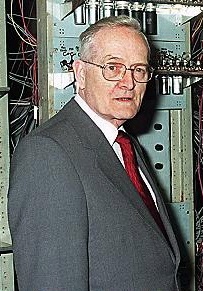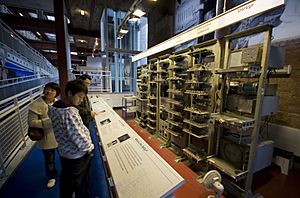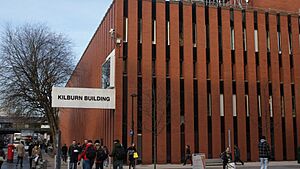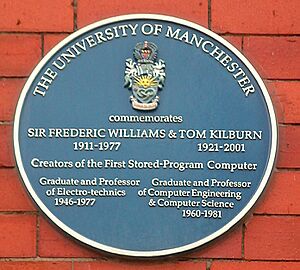Tom Kilburn facts for kids
Quick facts for kids
Tom Kilburn
|
|
|---|---|

Tom Kilburn
|
|
| Born | 11 August 1921 Dewsbury, Yorkshire, England
|
| Died | 17 January 2001 (aged 79) Manchester, England
|
| Nationality | English |
| Education | Wheelwright Grammar School for Boys |
| Alma mater |
|
| Known for | |
| Spouse(s) |
Irene Marsden
(m. 1943) |
| Children | 2 |
| Awards |
|
| Scientific career | |
| Institutions | |
| Thesis | A storage system for use with binary digital computing machines (1948) |
| Doctoral advisor | Frederic Calland Williams |
Tom Kilburn (born August 11, 1921 – died January 17, 2001) was a brilliant English mathematician and computer scientist. For over 30 years, he helped create five very important computers. He worked with Freddie Williams at the University of Manchester. Together, they developed the Williams–Kilburn tube and the world's first electronic stored-program computer, called the Manchester Baby. His work made Manchester and Britain leaders in the new field of computer science.
Tom Kilburn studied at Sidney Sussex College, Cambridge. During World War II, he worked on radar at the Telecommunications Research Establishment (TRE). After the war, Williams asked him to join the University of Manchester to build computers. Kilburn led the creation of many new Manchester computers. These included the Ferranti Mark 1, which was the world's first computer sold to businesses. He also helped create the Atlas, one of the first computers that could run many programs at once.
Contents
Early Life and School
Tom Kilburn was born on August 11, 1921, in Earlseaton, near Dewsbury, England. His father, John William Kilburn, worked in a wool mill. Tom was the only son.
From 1932 to 1940, he went to the Wheelwright Grammar School for Boys. The headmaster there saw that Tom was very good at mathematics. Tom also enjoyed sports, especially running.
In 1940, Kilburn started studying mathematics at Sidney Sussex College, Cambridge. Because of World War II, his courses were shorter, lasting only two years. He graduated in 1942 with excellent grades.
Building Early Computers
After graduating, Tom Kilburn was recruited to work on radar during the war. He was sent to the Telecommunications Research Establishment (TRE) in Malvern. There, he worked with Frederic Calland Williams on designing electronic circuits. Even though he didn't have much experience at first, Kilburn quickly became a valuable team member. On August 14, 1943, he married Irene Marsden. They had two children, a son named John and a daughter named Anne.
Kilburn's work during the war made him excited about building electronic computers. The biggest challenge then was finding a way to store information and instructions for computers. In July 1946, Kilburn and Williams created a storage device. It used a cathode ray tube (CRT) and was called the Williams–Kilburn tube. They filed a patent for it in 1946.
At first, it could only store one piece of information, called a bit. The image on the CRT would fade quickly. So, they found a way to read and refresh the information constantly. This made the data storage permanent. By December 1947, they could store 2,048 bits on a 6-inch wide CRT.
In December 1946, Williams moved to the University of Manchester. He asked Kilburn to join him there. They continued to improve their storage technology. In 1948, Kilburn used it to build the Manchester Baby. This machine became the first stored-program computer to run a program. It ran its first program on June 21, 1948. Kilburn earned his PhD in 1948 for his work on this storage system.
Manchester Computers
Kilburn had planned to go back to Malvern. But Williams convinced him to stay at the university. They worked on a project to develop the Ferranti Mark 1. This was the world's first computer sold for commercial use. Max Newman left the project, thinking engineers were more needed than mathematicians. Williams decided to focus on other areas, leaving Kilburn in charge. Alan Turing joined them in Manchester in 1948 and helped with the project.

The Mark I had new features like index registers. It combined CRTs with magnetic drum storage. Nine Mark I computers were sold between 1951 and 1957.
Over the next 30 years, Kilburn led the creation of many new Manchester computers. The first new computer, started in 1951, was an improved Mark I. It was called the "megacycle machine" or "Meg." It used solid state parts instead of vacuum tubes. This made it much faster. Kilburn also made it faster by using 10-bit parallel CRT memory. It was also one of the first computers to do floating point math. The Meg computer worked for the first time in 1954. Nineteen of these were sold by Ferranti as the 'Mercury' computer. Six of them went to customers in other countries.
While one team worked on Meg, Kilburn led another team with Dick Grimsdale and Douglas Webb. This team researched the next big step in computer design: using transistors. In November 1953, they finished a 48-bit machine. It was the world's first computer to use transistors. It had 550 diodes and 92 transistors. An improved version was finished in April 1955. It had 1,300 diodes and 200 transistors. This version was sold as the Metrovick 950.
Kilburn's next big project was called Atlas. The goal was to build a very fast computer using the best new and existing technologies. This project received a large grant. Atlas included many new ideas like multiprogramming (running many programs at once) and virtual memory. Virtual memory allowed the computer to use its slower drum storage as if it were faster memory. Three Atlas computers were built. They were installed at Manchester University, the University of London, and the Rutherford Laboratory.

Kilburn became a professor of computing engineering at Manchester in 1960. He helped create the Department of Computer Science in 1964. He was the first head of this department. He also served as the Dean of the Faculty of Science from 1970 to 1972. From 1976 to 1979, he was a pro-vice-chancellor of the university. His last computer project was the MU5. This computer was designed to make it easier to run programs written in high-level programming languages. The design of MU5 greatly influenced the successful ICL 2900 Series of computers.
Awards and Recognition
Tom Kilburn received many awards and honors throughout his life.
- In 1965, he became a Fellow of the Royal Society (FRS).
- In 1973, he was made a Commander of the Most Excellent Order of the British Empire (CBE).
- In 1974, he became a Distinguished Fellow of the British Computer Society.
- In 1978, he received the Royal Medal from the Royal Society.
- In 1982, he received the IEEE Computer Society Computer Pioneer Award.
- In 1983, he received the Eckert-Mauchly Award.
- In 1997, he was awarded the Mountbatten Medal.
- In 2000, he became a fellow of the Computer History Museum. This was for his work on early computer design, including random access digital storage, virtual memory, and multiprogramming.
A building at the University of Manchester is named "The Kilburn Building" in his honor. This building houses the Department of Computer Science.
Personal Life
Tom Kilburn married Irene Marsden in 1943. They had two children, a daughter and a son. The family often went on holidays to Blackpool. Kilburn always made sure to be back in time for Manchester United F.C.'s first football match of the season. He said that watching Manchester United win the 1968 European Cup Final was the best day of his life.
He retired early in 1981 to take care of his wife, who was very ill. Sadly, she passed away on August 3, 1981, just two weeks before his retirement.
After his wife's death, Kilburn lived alone in their house in Manchester. He never owned a personal computer himself. In 1998, he helped unveil a working copy of the Manchester Baby at the Manchester Museum of Science and Industry.
Tom Kilburn died on January 17, 2001, at Trafford General Hospital. He passed away from pneumonia after having surgery.
Images for kids



